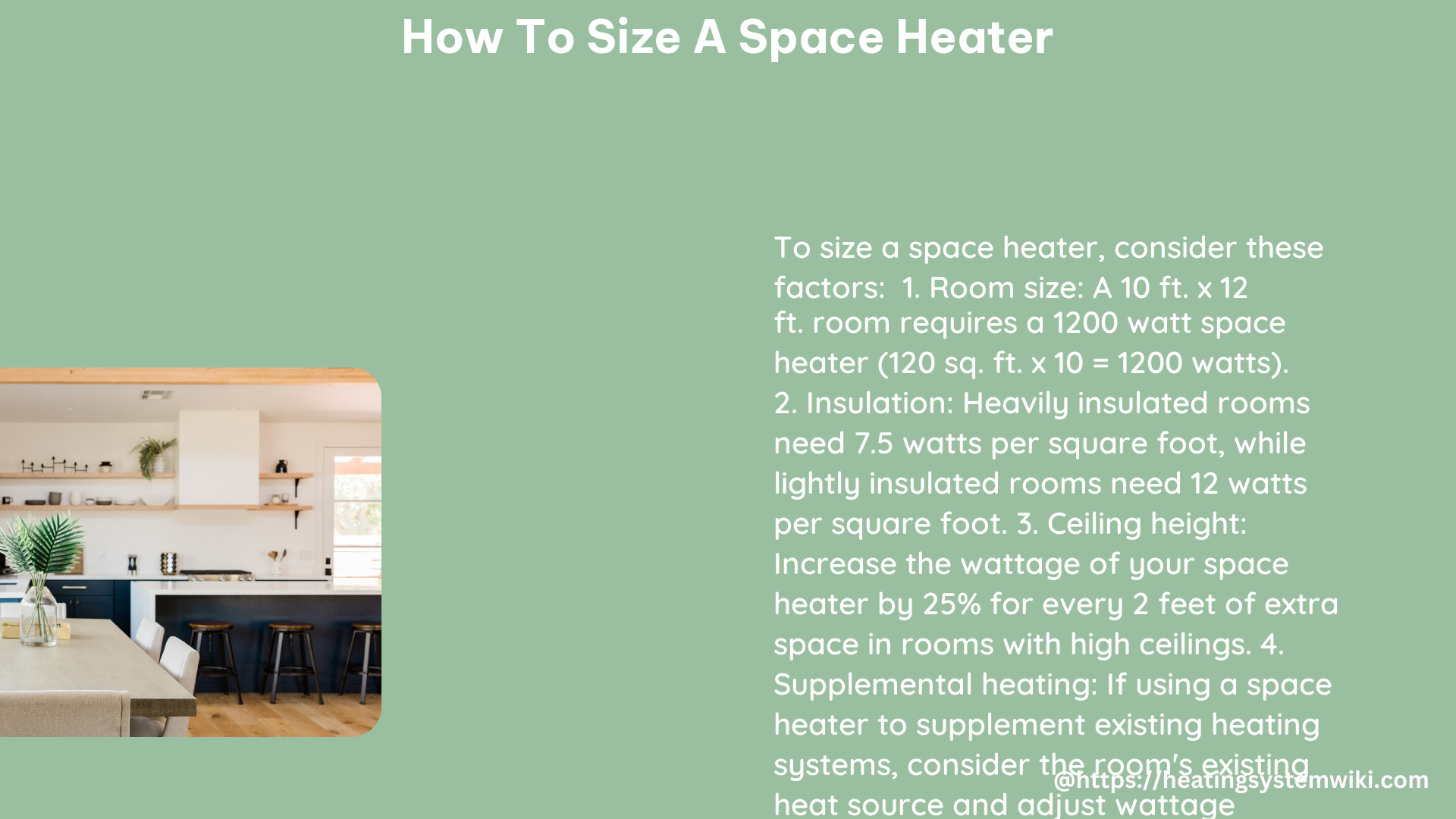When it comes to heating your living space, choosing the right size space heater can make all the difference in terms of energy efficiency, cost-effectiveness, and comfort. To properly size a space heater, you need to consider several key factors, including the room size, insulation, ceiling height, and outside temperature. This comprehensive guide will walk you through the process step-by-step, ensuring you select the perfect space heater for your needs.
Factors to Consider When Sizing a Space Heater
Room Size
The primary factor in determining the appropriate space heater size is the square footage of the room you plan to heat. As a general rule of thumb, you’ll want to use 10 watts of power per square foot of space. For example, a 120 square foot room would require a 1,200-watt space heater (120 sq ft x 10 watts = 1,200 watts).
However, this is just a starting point, as other factors can influence the actual wattage needed.
Insulation
The level of insulation in the room plays a significant role in the amount of power required. Heavily insulated rooms retain heat more efficiently, requiring less power to maintain a comfortable temperature. Conversely, lightly insulated or uninsulated rooms, such as garages and basements, will need more wattage to effectively heat the space.
To account for insulation, you can adjust the wattage calculation as follows:
– Well-insulated rooms: Reduce the wattage by 20-30%
– Moderately insulated rooms: Use the standard 10 watts per square foot
– Poorly insulated rooms: Increase the wattage by 20-30%
Ceiling Height
Rooms with high ceilings (above 8 feet) may require additional wattage to effectively heat the entire space. This is because the warm air tends to rise, leaving the lower living area cooler. As a general guideline, increase the wattage by 10-20% for every foot of ceiling height above 8 feet.
Outside Temperature
The outside temperature can also impact the wattage needed to heat a room. Colder outdoor temperatures will require more power to maintain a comfortable indoor temperature. As a rule of thumb, increase the wattage by 10-20% for every 10°F (5.6°C) drop in outside temperature below 70°F (21°C).
Calculating the Optimal Wattage

To determine the optimal wattage for your space heater, follow these steps:
- Measure the square footage of the room you want to heat.
- Assess the insulation level of the room and adjust the wattage accordingly (20-30% reduction for well-insulated rooms, 20-30% increase for poorly insulated rooms).
- Consider the ceiling height and adjust the wattage if necessary (10-20% increase per foot above 8 feet).
- Factor in the outside temperature and adjust the wattage if needed (10-20% increase per 10°F/5.6°C drop below 70°F/21°C).
- Use the formula: Square footage x Adjusted Wattage Factor = Required Wattage
For example, let’s say you have a 150 square foot room with moderate insulation, 9-foot ceilings, and an outside temperature of 40°F (4.4°C). The calculation would be:
- Room size: 150 square feet
- Insulation factor: 1.0 (no adjustment needed for moderate insulation)
- Ceiling height factor: 1.1 (9 feet, 10% increase)
- Outside temperature factor: 1.2 (40°F, 20% increase)
- Required wattage: 150 sq ft x (10 watts/sq ft) x 1.0 x 1.1 x 1.2 = 1,980 watts
In this case, you would need a space heater with a minimum of 1,980 watts to effectively heat the 150 square foot room.
Supplementing Central Heating Systems
If you’re using a space heater to supplement a central heating system, you’ll need to take into account the existing heating capacity. In this scenario, you can use a space heater sizing calculator, such as the one provided by Heat Wagon, to determine the required BTUs (British Thermal Units) for your space.
When shopping for a space heater, look for the wattage necessary to heat your specific area and convert it to BTUs using the formula: 1 watt x 3.41 = BTUs. For example, a 150 square foot space would require a heater that provides 4,262 BTUs (1,250 watts x 3.41 = 4,262 BTUs).
Safety Considerations
In addition to selecting the appropriate wattage, it’s crucial to consider the safety features of the space heater you choose. Look for models with the following safety features:
- Auto shut-off: Automatically turns off the heater if it tips over or overheats.
- Tip-over protection: Shuts off the heater if it’s knocked over.
- Cool-touch exterior: Prevents burns from accidental contact with the heater.
These safety features can help prevent accidents and provide peace of mind when using the space heater.
By following the guidelines outlined in this comprehensive guide, you can accurately size a space heater to meet your specific heating needs, ensuring maximum efficiency, cost-effectiveness, and safety. Remember, proper sizing is key to achieving a comfortable and energy-efficient heating solution for your living space.
References:
- King Electric – How to Size an Electric Heater to Your Room: https://king-electric.com/pro-tips/how-to-size-an-electric-heater-to-your-room/
- Heat Wagon – Heater Size BTU Calculator: https://heatwagon.com/heater-size-btu-calculator/
- ABT – Space Heater Buying Guide: https://www.abt.com/learn/space-heater-buying-guide
